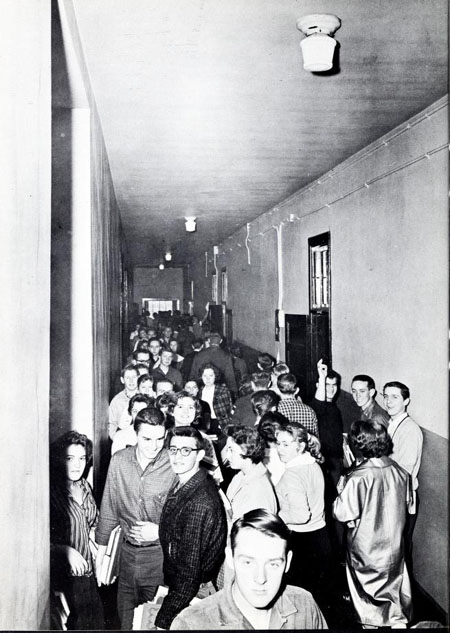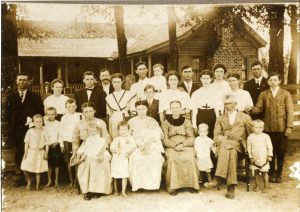
Abhego Atkinson Family Reunion, Beulah Township, 1912
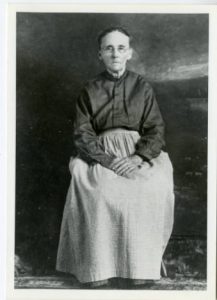
Spicy Elizabeth Hayes Barefoot (1862-1931)
This December the Digital Heritage Center team took a field trip to Johnston County Heritage Center in Smithfield, North Carolina to do a session of on-location scanning. The Heritage Center is the former home office of First Citizens Bank in downtown Smithfield and includes exhibit space as well as storage for historic artifacts and records pertaining to Johnston County history. Armed with two flatbed scanners, laptops, external hard drives, and an armful of cords and cables, team members set to work scanning and filling out metadata for over 200 photographs that are now available on DigitalNC.
These photographs are part of Johnston county’s portrait collection depicting individuals from Johnston County and beyond. Many of the portraits from the session included labels detailing names, dates, and locations describing the photo. This information was recorded on-site during the scanning process, and makes for a useful set of images for those interested in genealogy or more broadly in Johnston County history. The number of well-labeled group family portraits in this collection make it great for tracing family history, and the Digital Heritage team enjoyed tracking individuals across different times and settings as we scanned.
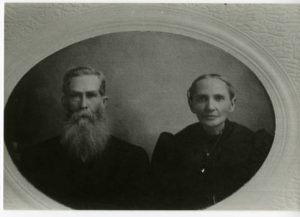
Reverend Jesse and Susanna Watkins Wheeler
To learn more about on-location scanning, take a look at our previous blogpost detailing the initiative. To learn more about our partner Johnston County Heritage Center, and to see more of their materials, take a look at their DigitalNC partner page or check out their website.
We were excited this past semester to partner with the AMST 475H, Documenting Communities class here at UNC to show them how a digitization project works from star to finish. This is a guest post from the class.
Written by: Dani Callahan and Lucas Kelley
New material that documents the unionization of the Gastonia’s Firestone Mill have been added to DigitalNC’s existing collection on the mill: the Loray Digital Archive. The Gaston County Museum of Art and History provided the materials for digitization, and UNC-Chapel Hill students in Professor Robert Allen’s Documenting Communities course scanned the material, researched the unionization movement, and added metadata to the documents.
The unionization of the Firestone Mill occurred in the late 1980s and was particularly contentious both within the mill community and throughout the region. The violent unionization efforts of the 1920s, exemplified in the Loray strike of 1929, had left deep wounds within Gastonia, and area residents and workers had traditionally distrusted subsequent unionization attempts. The widespread economic downturn in the textile industry in the 1980s, however, meant harsher conditions and less pay for the workers at Firestone, and some workers hoped the United Rubber Workers Union could provide protection from the difficult economic climate.
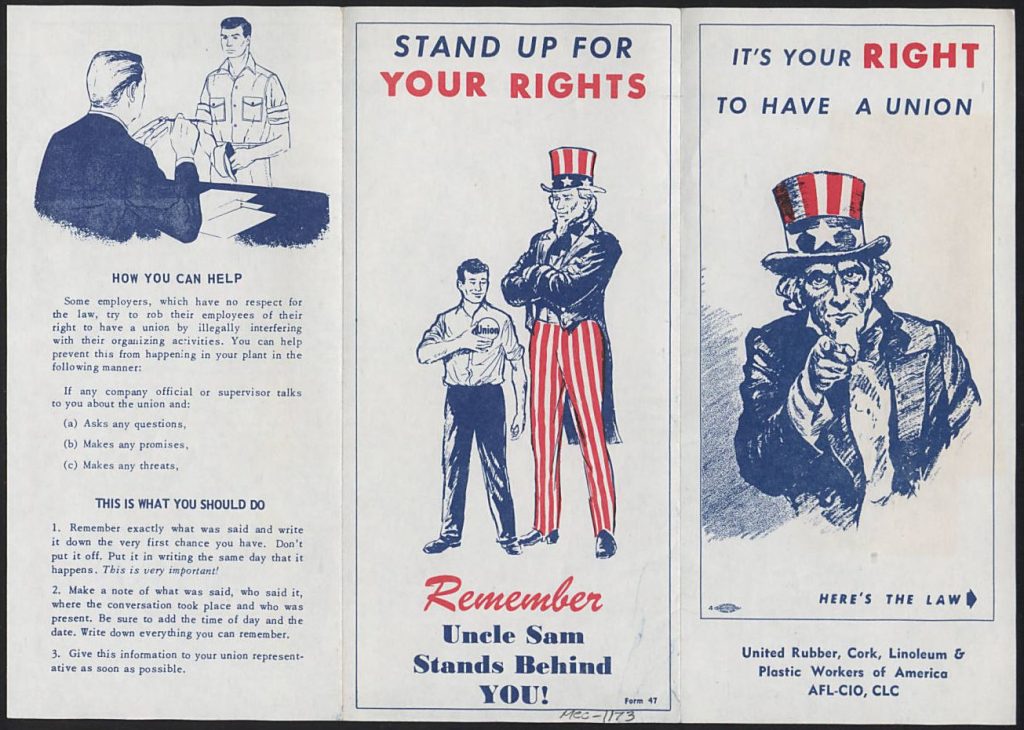
Pro-union pamphlet distributed to employees at Firestone Mill in the late 1980s. It was produced by the AFL-CIO.
The materials added to the Loray Digital Archive document the pro-union and anti-union campaigns. Each side sought to attract workers to their cause with flyers, posters, stickers, buttons, and pamphlets. Initially, the anti-union forces held off the unionization attempt in 1987. Widespread media coverage turned the referendum into a political circus and leaders of the pro-union movement could not overcome area residents’ distrust. Yet a year later, Firestone workers voted to join the union in a campaign that was much more subdued. The success of pro-union forces was due in large part to the diligence of the union’s committee members working inside the mill. While the 1987 vote had turned into a regional and even national media circus, the 1988 vote remained an internal debate housed within Firestone itself. When the workers at the Firestone Mill voted on April 14th, 1988 to join the United Rubber, Cork, Linoleum and Plastic Workers by a narrow margin, it was a victory nearly sixty years in the making. Click the link view all the materials from the 1980s union effort.
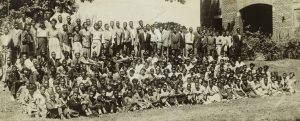
Photo in the 14th Street School scrapbook showing classes in front of the school.
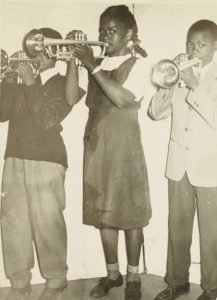
Practicing trumpet for the school band in the 14th Street School Scrapbook.
A batch of new materials from Forsyth County Public Library are now available on DigitalNC. Included are two scrapbooks, one from the 14th Street School in Winston-Salem and one from the Society for the Study of Afro-American History in Winston-Salem. Also included are materials from the Malloy/Jordan East Winston Heritage Center and the East Winston Branch Library, and yearbooks from St. Anne’s Academy and Atkins High School.
The 14th Street School educated African-American students in Forsyth County from its founding in 1924 through the 1970s. This scrapbook collects photographs of student activities and events. Included are photographs of sports teams, the school band, dance performances, and class portraits. The 14th Street School acted as a community hub and created lasting bonds within its student body which remain strong to this day. Despite its closure, alumni continue to hold reunions and advocate for the school as an important part of Winston-Salem history.
Additionally a scrapbook from the Society for the Study of Afro-American History in Winston-Salem (now called the Society for the Study of African American History in Winston Salem) collects calendars created from 1989 through 1997. These calendars include images and write-ups of Winston-Salem history and events as well as photographs and information about Society events.
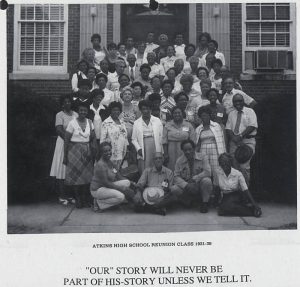
A page of the 1989 calendar by the Society for the Study of Afro-American History showing a reunion of the 14th Street School classes of 1931-1939.
The Maroon and Gold 1948-1949 yearbook from Atkins High School and The Annette 1952 yearbook from St. Anne’s Academy are also now available. Atkins High School was founded in 1930 for African-American students in Winston-Salem. The school was named for Dr. Simon Green Atkins, the founder and first president of Winston-Salem University. Dr. Atkins was born into slavery in 1863 on a farm in North Carolina but was able to receive a public education after the end of the Civil War. He went on to attend St. Augustine College and subsequently dedicated his life to improving education for African Americans.
To see these and the other items from this batch of materials, visit the links below.
To see other materials from Forsyth County Public Library visit their partner page or take a look at their website.
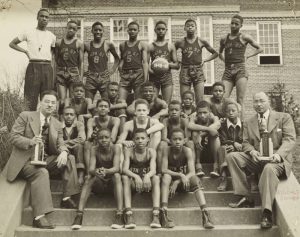
The 1948-1949 14th Street School basketball team as seen in the scrapbook.
The North Carolina Digital Heritage Center recently digitized a variety of materials from the Stanly County Museum in Albemarle, N.C. Prominent in the materials is information on the Jones family.
The Jones Family Materials
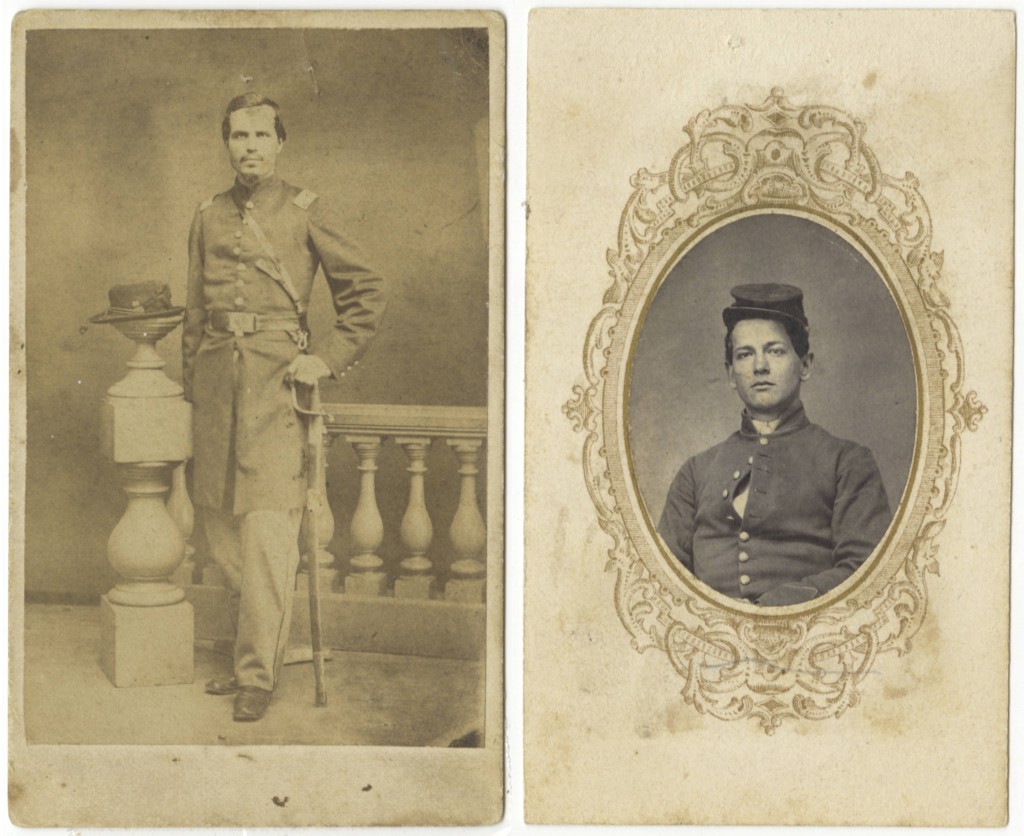
Brothers James Read Jones, left, and Will Jones (circa 1861-1862). Both were soldiers from Indiana in the Union army. Their letters, among others, comprise the Jones Family Letter Collection from the Stanly County Museum.
The Jones Family Letter Collection was donated to the Stanly County Museum by Janice H. Mitchener. The letters, which number in the hundreds, are correspondence between James Read Jones, his wife Achsah Gilbert Pleas Jones, and various friends and other members of their family. The complete, numbered letters appear first in the collection (Letters 1-169), followed by incomplete letters (Loose 1-51). Biographical information about the Jones family is at the end of the letter collection (Documents 1-5). The numbered letters are roughly grouped–first are James Read Jones’s letters, and then Achsah Gilbert Pleas Jones’s letters (for a chronology, see Document 5).
The correspondence tracks many threads: the couple’s relationship, from infancy to past marriage, and the life and death in 1862 of Will Jones, James Read Jones’s brother. Though the letters date from January 1861 to April 1894, the bulk of the letters date from 1861-1862, when James and his brother served in the Union army. As Documents 2-4 detail, Sergeant J. R. Jones was mustered into Company E, 36th Regiment of the Indiana Infantry, in September 1861. He met Achsah Gilbert Pleas and on April 7, 1862, just after the Battle of Shiloh, they were married. Sgt. Jones was promoted to Second Lieutenant in March 1862 but discharged for an inguinal hernia on December 2, 1862. He then spent much of his life traveling the world as a Quaker minister, while Achsah raised their children in North Carolina. Achsah and Jimmy were married until Achsah’s death in 1898.
The Jones Family materials also includes a scrapbook. The James Read Jones Scrapbook of Writings is a collection of letters and newspaper clippings by or about James Read Jones. Dated materials in the collection range from 1885-1911. The scrapbook includes many newspaper columns and articles written by J. R. Jones, as well as assorted correspondence, photographs, and poems.
School newspapers
Also new are newspapers from two Albemarle schools. There are two late 1930s issues of The Seven Stars newspaper from Albemarle Central Elementary School, and several volumes of The Full Moon newspaper from Albemarle High School:
- Volume 11, numbers 3-4 (December 14, 1934 – February 14, 1935)
- Volume 12, numbers 1-6 (October 18, 1935 – May 15, 1936)
- Volumes 24-33 (October 3, 1958 – May 24, 1967)
- Volumes 56-63 (September 1990 – June 1998)
Other new materials include:
- Dr. Francis J. Kron: A Report Prepared for the Division of State Parks, North Carolina Department of Conservation and Development. A report on the life, dwelling, and writings of Dr. Francis J. Kron, by Robert O. Poplin, Jr., The report also includes interviews conducted with family and acquaintances. The Kron house was used as the model for the lodge and bathrooms at Morrow Mountain State Park in Stanly County, N.C.
- Business Books: Unidentified Business Ledger, most likely from a general store (1849-1850); E.M. Asbury and Company Business Ledger and Minute Book (1902-1909); Marlise Hotel Register (1908-1910)
- Two minute books (1970-1976, 1976-1984) from Delta Kappa Gamma, Eta State (N.C.), Psi Chapter. The Delta Kappa Gamma Society International is a professional honor society for women educators.
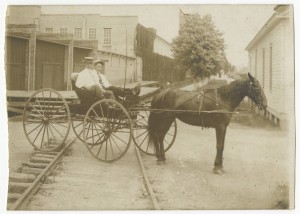
Postcard of a buggy on the railroad tracks in Albemarle, N.C. circa 1905.
- A History of the Albemarle Woman’s Club, 1915-1965 (1965)
- Images of Stanly County: Portraits of the Jones and the Hearne families, several additions to Stanly County postcards, and a mysterious photograph of Burton Tucker. Though the picture is dated 1892, Tucker is believed to have been murdered by Alec Whitley in Arkadelphia, Arkansas in April 1891.
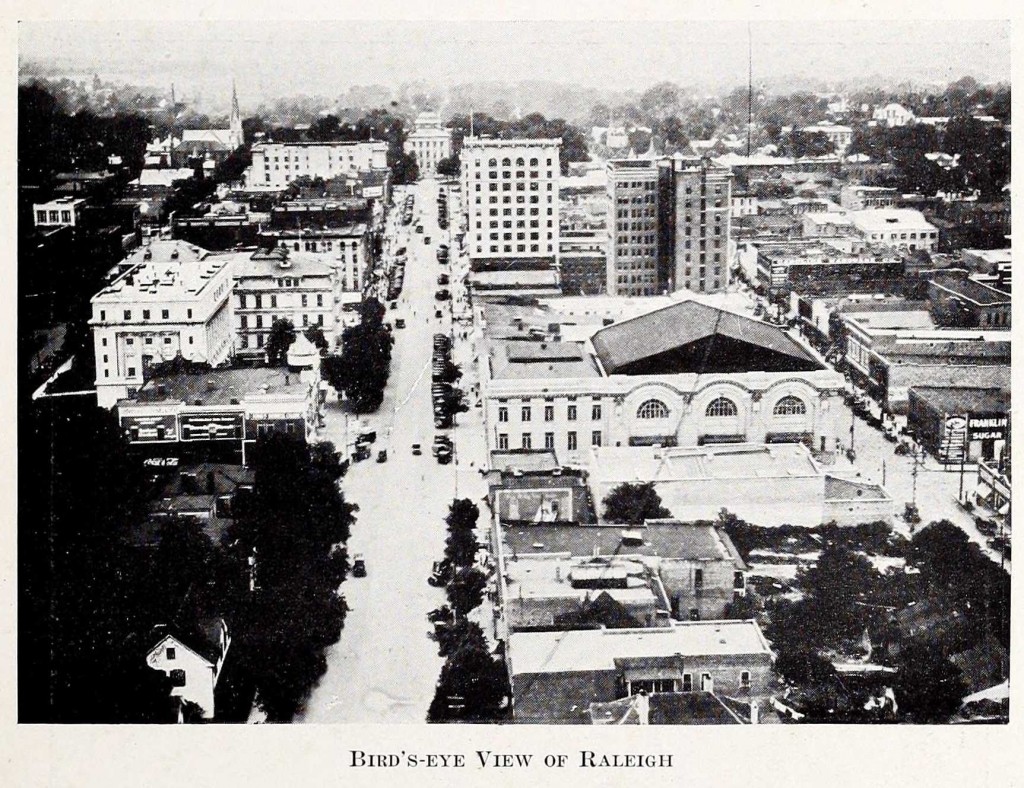
From the 1922 Rattler, Raleigh High School’s yearbook. Part of a photo essay of Raleigh.
The Digital Heritage Center partnered for the first time with the Olivia Raney Local History Library in Raleigh to digitize nearly a hundred Wake County school yearbooks, catalogs, reunion books, and graduation programs. The materials, which span 1909-2008, are windows into the daily lives and times of North Carolinians throughout the century.
Some of these yearbooks come from schools no longer in operation. Here, we’ve provided a brief history of each former school (when available), and a link to the volumes from that school (see section “Closed Schools” below). We also digitized yearbooks from schools that still exist today (see “Current Schools” section at end).
Closed Schools
Charles B. Aycock Junior High School (Raleigh, N.C.)
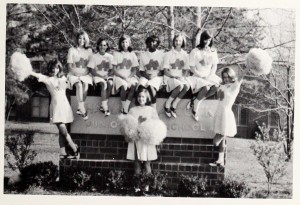
Aycock Junior High School Cheerleaders, 1969.
History: Junior high school in operation from 1965-1979, when its campus was absorbed by William G. Enloe High School, which was built in 1962. The building was and still is known as the “East Building” on Enloe’s campus. Its original students were from the recently closed Hugh Morson Junior High School (formerly Hugh Morson High School).
Volumes: Aycock [1967]; Charles B. Aycock Junior High School [1974]; six of The Owl’s Nest [1968-1973]; two of Owl’s Nest [1975-1976]
Fuquay Springs High School (Fuquay-Varina, N.C.)
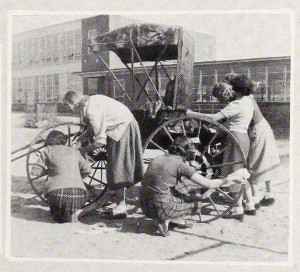
Students of Fuquay Springs High School at work, 1953.
History: Three elementary schools in the area joined together to open Fuquay Springs High School in 1918. The was renamed Fuquay Varina High School in 1963 and operated until fall 1970, when it combined with Fuquay Consolidated High School to form the new Fuquay-Varina High School. That school is still in operation today (history from Fuquay-Varina High School website).
Volumes: three of The Greenbriar [1953-64]
Hugh Morson High School (Raleigh, N.C.)
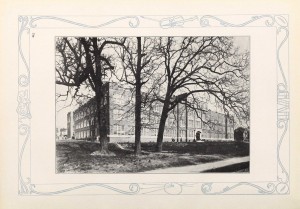
Hugh Morson High School, 1928.
History: On September 2, 1925 the students of the overcrowded Raleigh High School moved into the brand new school called Hugh Morson. The school spanned the block of Morgan Street bounded by Person, Blount, and Hargett Streets. It was named for the long-time teacher and beloved first principal at Raleigh High School, Mr. Hugh Morson. Today, all that remains is a plaque and two gargoyles. The school newspaper was The Purple and Gold; its colors, purple and gold. These colors live on today as the colors of Needham B. Broughton High School (more details in this Good Night Raleigh post; history summarized from an excellent entry in Historical sketches of the Raleigh Public Schools by Mrs J. M. Barbee, 1943).
Hugh Morson High School was demoted to a junior high school in 1955 and operated until 1965, when it closed. Over winter break in 1965, the students were transferred to the new Charles B. Aycock Junior High School and the school was officially closed and demolished in 1966.
Volumes: 18 of The Oak Leaf [1927-1955]; Morson Memories [1962]; Hugh Morson High School Class of 1955 50th Year Reunion Memorial Directory [2005]
Hugh Morson Junior High School (Raleigh, N.C.)
Volumes: PTA Year Book [1963]; Morson Junior High [1964]
Raleigh High School (Raleigh, N.C.)
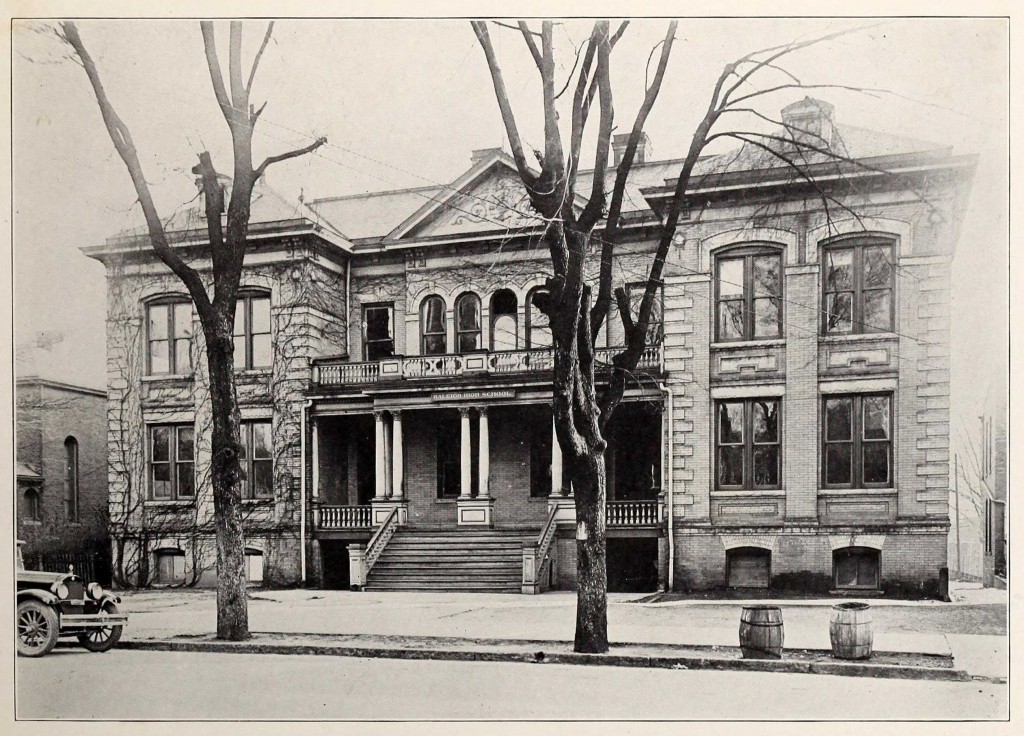
The Raleigh High School building on W. Morgan St, 1923. The school closed in 1929 and was later demolished.
History: Raleigh High School, which preceded both Hugh Morson and Broughton High Schools, was built in 1909 next to “the Raleigh water tower, across the street from fire station #1, on W. Morgan Street” (Good Night Raleigh post). The city of Raleigh decided to build a high school in 1905, reported the News and Observer. The paper also reported that the school’s principal would be Professor Hugh Morson, who ran a successful and well-known boys’ school. The West Morgan Street location was selected for its proximity to both the State and Olivia Raney libraries (the school had no library of its own). The school was built to contain 250-300 students in 1907, but enrollment was soon up to 500. The school built a two-story brick annex during 1921-1922, just east of the city water tower. But schools were soon closed during an influenza pandemic, and the buildings of the high school were used to house patients. In, fact, the school never re-opened. By 1928-1929, the building closed for good, as Hugh Morson and Needham B. Broughton High Schools had both been built. Later the building was used by the Salvation Army, and then divvied up and sold. (Note: history summarized from an excellent entry in Historical sketches of the Raleigh Public Schools by Mrs J. M. Barbee, 1943)
Volumes: seven of The Rattler [1909-1923]; Rattler [1913]; Cylinder [1924]
Rolesville High School (Rolesville, N.C.)
Volumes:Blue Devils [1960]
James E. Shepard High School (Zebulon, N.C.)
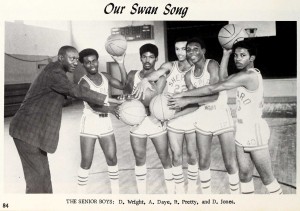
Shepard High School boys’ basketball seniors, 1970.
History: African-American high school from 1933-1970.
Volumes: The Lion [1970]
Wakelon High School (Zebulon, N.C.)
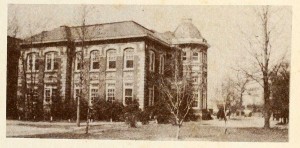
Wakelon High School, side view, 1948.
History: Wakelon School opened in 1908 in an “eclectic brick building” in Italian/Neoclassical style (National Register of Historic Places; the building was added in 1976). It was designed by C. E. Hartage, a Raleigh architect, and features a prominent center octagonal tower. The school’s construction was a big boon for the town of Zebulon, which was incorporated just a year before the school’s construction. Its construction was a result of the 1907 General Assembly act that also established Cary High School. It operated until it was merged with the integrated Zebulon Elementary. The last of the students graduated in the 1980s, and the building was sold to GlaxoSmithKline. It has since been bought back and is now a town hall.
Volumes: two of The Wak-Igh-An [1941-1948]
Washington High School (Raleigh, N.C.)
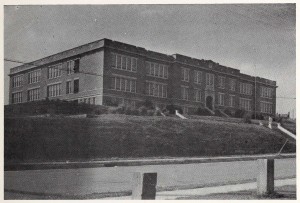
Washington High School building, 1945.
History: In 1869, a school for African-American students was built at West South Street in Raleigh by the American Missionary Society of New York. The school was bought in 1875 by the city of Raleigh and organized as a public elementary school. The school grew, but by 1918 Shaw University and St. Augustine’s College had both discontinued their high school programs, leaving Black students nowhere to pursue education beyond the elementary level. In the fall of 1924, Washington Elementary and High School opened (Historical sketches of the Raleigh Public Schools by Mrs J. M. Barbee, 1943). It was designed by C. A. Gadsen Sayre in the Jacobean style, a popular style for school architecture in in the 1920s, and continued as the only public high school for African Americans in Raleigh from its inception until 1953 (Raleigh Historic Development Commission). The building now holds Washington Gifted and Talented Magnet Elementary School.
Volumes: two of The Echo [1945-1950]
Current Schools
Cary High School (Cary, N.C.)
Volumes: three of Catalogue [1925-1927], a course catalog and campus publication with photographs of the classes and details of the curriculum; yearbooks: The Chsite [1920]; Chsite [1924], six of The Yrac [1952-1962]
St. Mary’s School (Raleigh, N.C.)
Volumes: The Muse [1917]; five of The Stage Coach [1927-1945]
North Carolina State School for the Blind and the Deaf (Raleigh, N.C.)
Now the Governor Morehead School for the Blind.
Volumes: four of The Reflector [1954-1960]
Needham B. Broughton High School (Raleigh, N.C.)
Volumes: 21 of The Latipac [1931-1964]; Needham Broughton High School Classes of 1939-1940 Reunion XXXXV [1984]; Perspectives: 50th Reunion, Class of 1958 [2008]; Journeys: NBBHS Class of 1959 50th Reunion [2009]
To view all of the new Wake County materials, click here. And click here to view all yearbooks from Wake County area high schools.
Early student yearbooks from Lincolnton High School and Union High School are now available in the North Carolina High School Yearbooks collection on DigitalNC, thanks to the Lincoln County Public Library. There are 55 volumes online, ranging in date from 1923 to 1962. The image below is from the 1960 edition of The Pine Burr, from Lincolnton High School.

Another 32 newspaper titles are up on DigitalNC this week! Three of these titles are from North Carolina towns that either changed their names or just don’t exist anymore.
First, we have the North Carolina National from Company Shops, North Carolina. Company Shops was a community formed around the railroad car construction and maintenance industry in Alamance County, between Graham and Gibsonville. Due to growing anti-railroad sentiments, the community of Company Shops decided to appoint a committee to change the name of the town in 1887. This committee decided on the name ‘Burlington.’
Next up is Our Home from Beaver Dam, North Carolina. It’s hard to determine exactly where Beaver Dam would have been, but knowing that the paper is from Union County, it seems possible that it was located near Beaverdam Creek, just south of Wingate and Marshville, North Carolina.
Lastly, we have The Hokeville Express from what was once known as Hokeville, or ‘Lincoln Factory,’ North Carolina. It seems likely that the community was named after the affluent Hoke family of Lincolnton. Col. John Hoke was one of the owners of the profitable Lincoln Cotton Mills. Col. Hoke died in 1845 and passed ownership on to his son, also named John Hoke. The factory burned down in 1862, and the following year the Confederate Army began constructing a laboratory on the site to manufacture medicines, such as ether, chloroform, and opiates. Since then the community has gone by the name ‘Laboratory.’
Over the next year, we’ll be adding millions of newspaper images to DigitalNC. These images were originally digitized a number of years ago in a partnership with Newspapers.com. That project focused on scanning microfilmed papers published before 1923 held by the North Carolina Collection in Wilson Special Collections Library. While you can currently search all of those pre-1923 issues on Newspapers.com, over the next year we will also make them available in our newspaper database as well. This will allow you to search that content alongside the 2 million pages already on our site – all completely open access and free to use.
This week’s additions include:
- The Daily Standard (Concord, N.C.) – 1893-1895
- Daily Concord Standard (Concord, N.C.) – 1895-1902
- Southern Voice (Bethel, N.C.) – 1890
- Berea Gazette (Berea, N.C.) – 1877-1878
- North Carolina National (Company Shops, N.C.) – 1882
- The Alliance Weekly (Hillsborough, N.C.) – 1896
- Hillsborough Plaindealer (Hillsborough, N.C.) – 1861
- North Carolina Democrat (Hillsborough, N.C.) – 1849-1850
- The Naked Truth (High Point, N.C.) – 1896
- Farm and Fireside (High Point, N.C.) – 1883
- High Point Reporter (High Point, N.C.) – 1860
- Our Home (Beaver Dam, N.C.) – 1893
- The Progressive Reformer (Kings Mountain, N.C.) – 1896
- The Ashe Reporter (Jefferson, N.C.) – 1892
- The Southern Home (Kernersville, N.C.) – 1887
- The Hokeville Express (Hokeville, N.C.) – 1855
- Gazette (Kinston, N.C.) – 1873
- The Mountaineer (Morganton, N.C.) – 1883
- The Carolina Mountaineer (Morganton, N.C.) – 1883-1884
- The Anglo-Saxon (Rockingham, N.C.) – 1902-1908
- The Ansonian (Polkton, N.C.) – 1874-1876
- Jonesville Enterprise (Jonesville, N.C.) – 1858
- The Rubicon (Yanceyville, N.C.) – 1840
- The Concord Daily Tribune (Concord, N.C.) – 1910-1918
- The Burlington News (Burlington, N.C.) – 1900
- New Berne Weekly Journal (New Bern, N.C.) – 1908-1910
- The Anson Times (Wadesboro, N.C.) – 1881-1886
- The Moore County News (Carthage, N.C.) – 1920-1922
- The Canton Enterprise (Canton, N.C.) – 1920-1942
- The Chatham Record (Pittsboro, N.C.) – 1904-1922
- The Times (Concord, N.C.) – 1885-1894
- The Concord Times (Concord, N.C.) – 1894-1922
If you want to see all of the newspapers we have available on DigitalNC, you can find them here. Thanks to UNC-Chapel Hill Libraries for permission to and support for adding all of this content as well as the content to come. We also thank the North Caroliniana Society for providing funding to support staff working on this project.
Thanks to our partner, South Piedmont Community College, a batch containing catalogs from South Piedmont Community College and Anson Community College covering the years from 1991 to 2000 and 2018 to 2021 are now available on our website. The catalogs include information on academic policies, student support services, student life, community organizations, administrators, faculty, various programs of study, and course descriptions.
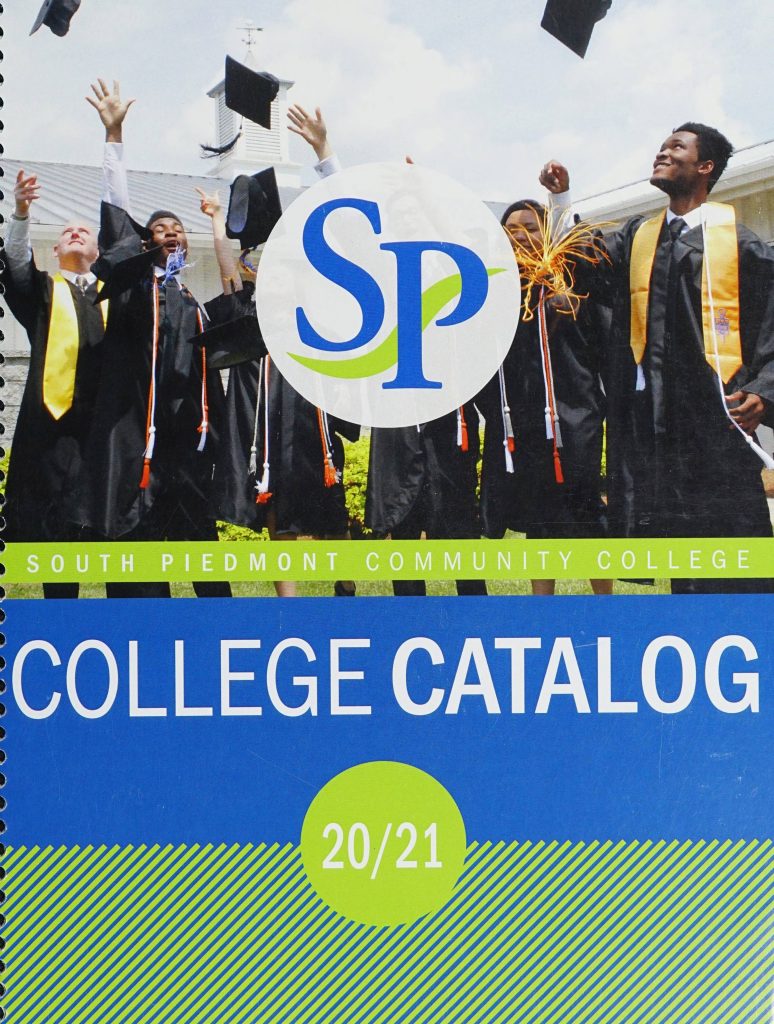
Anson Community College began as the Ansonville Industrial Education Center in 1962. After the appointment of a Board of Trustees by the Board of Education and Anson County Commissioners in 1967, the Center became the Anson Technical Institute. Twelve years later in 1979, the name was again changed to Anson Technical College in order to better reflect the offerings of the school. The name of the college was changed for the last time to Anson Community College in 1987 before consolidating with the Union Technical Education Center.
On August 3, 1999 the South Piedmont Community College was created from the consolidation of Anson Community College and Union Technical Education Center to better serve Anson as well as Union County residents. The college today continues to grow and expand its operations, but still strives to maintain providing hands-on experience as well as one-on-one instruction to its students.
To learn more about South Piedmont Community College, please visit their website.
To view more South Piedmont and Anson Community College catalogs on our website, click here.
Over forty years worth of campus catalogs from South Piedmont Community College are now online at DigitalNC. They cover admissions, student registration for classes, financial aid, scheduling, and the lists of programs and classes.
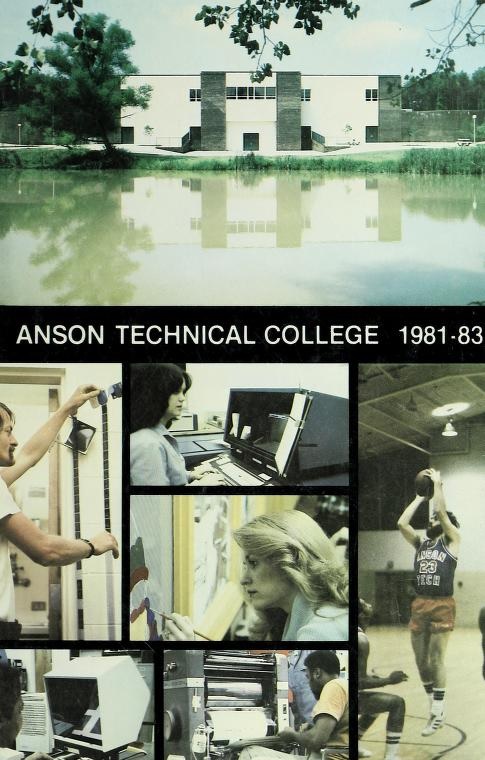
The Anson Technical College Catalogue for 1981-1983.
These campus publications range from 1972 to 2017. In the 1970s, it was still called Anson Technical Institute, but the name was later changed to Anson Technical College in 1979 and Anson Community College in 1987. In 1999, South Piedmont Community College was created out of Anson Community College and Union Technical Education Center, in order to serve both Anson County and Union County, where the campuses still serve today. Also included is a commemorative program for Donald Altieri, who served as former President of the college from 1993-2003.
Click here to browse through the SPCC catalogs. To learn more about South Piedmont Community College, visit their partner page, or take a look at their website.
Two dozen editions of the South Piedmont Community College Insider are now online on DigitalNC. They date back to 1998, when it was still called the Anson Community College Insider, before SPCC was created in 1999 to service both Anson and Union County.
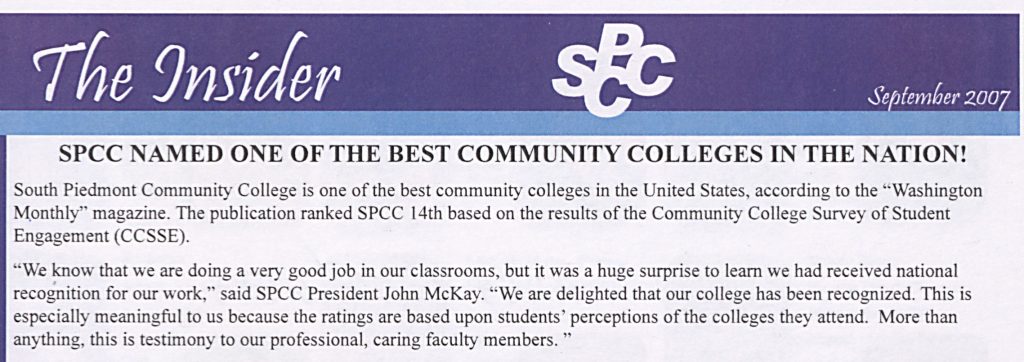
SPCC was named one of the nation’s best community colleges in September of 2007
The Insider served as a campus newsletter for SPCC students, including articles on local events, new developments and programs that are being offered on campus, and news about campus staff, faculty, and grants. It also advertised educational help for writing term papers and assistance with using the computer labs on campus.
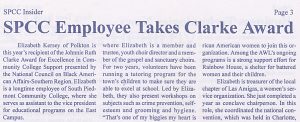
Employee Elizabeth Kersey received an award for Excellence in Community College Support
Also included are a few press clippings from the Anson Record and the Charlotte Observer to advertise the school’s programs and to celebrate the five-year anniversary of the creation of SPCC.
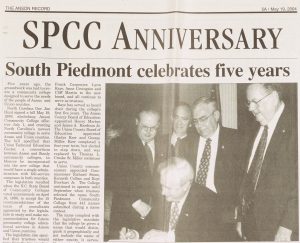
The Anson Record celebrates 5 years of SPCC
To check out more of the SPCC Insiders, they are available here and the press clippings are here. To learn more about South Piedmont Community College, visit their partner page or take a look at their website.


















